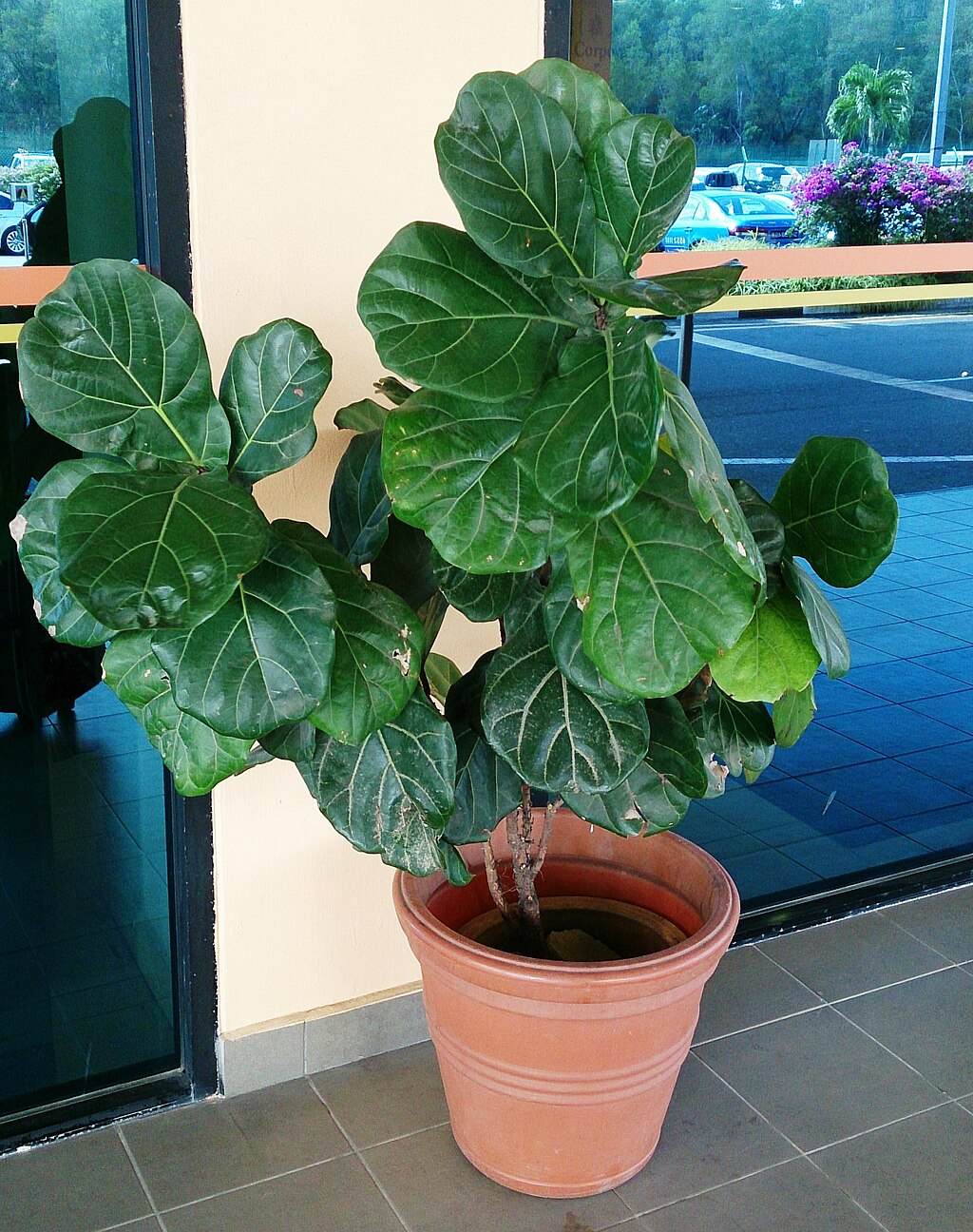Botanical Details and Popular Varieties:
- Botanical Information:
- Genus: Ficus (Family: Moraceae)
- Native to tropical and subtropical regions (Asia, Africa, Central America)
- Popular Ficus Varieties:
- Ficus elastica (Rubber Plant)
- Ficus lyrata (Fiddle Leaf Fig)
- Ficus benjamina (Weeping Fig)
- Ficus microcarpa (Ginseng Ficus)
- Ficus pumila (Creeping Fig)
Ideal Growing Conditions:
Here are some general care tips that apply to most Ficus varieties (including Ficus elastica, Ficus benjamina, Ficus lyrata, and others) to ensure they thrive in your home:
1. Light Requirements
- Bright, Indirect Light: Most Ficus plants thrive in bright, indirect light. Place your Ficus near a window with filtered light or in a spot where it gets plenty of natural light but isn’t exposed to harsh direct sun, which can scorch the leaves.
- Tolerance for Low Light: Some Ficus varieties (like Ficus benjamina) can tolerate lower light conditions but may not grow as vigorously and could drop leaves.
2. Watering
- Water When Dry: Water your Ficus only when the top 1-2 inches of soil feel dry to the touch. Overwatering is a common cause of root rot, so ensure the pot has good drainage.
- Avoid Standing Water: Make sure excess water can escape from the drainage holes. Empty the saucer underneath the pot after watering to prevent root rot.
- Seasonal Watering: During the growing season (spring and summer), water more frequently. In fall and winter, reduce watering as the plant enters a dormant phase and requires less moisture.
3. Temperature & Humidity
- Warm Temperatures: Ficus plants generally prefer temperatures between 60°F to 75°F. They don’t handle cold drafts well, so avoid placing them near air conditioners or heaters.
- Moderate Humidity: While Ficus can tolerate average household humidity, they will thrive in a bit more humidity. If the air is too dry (especially in winter), consider using a humidifier or placing the plant on a tray with pebbles and water to increase humidity.
4. Soil Type
- Well-Draining Soil: Ficus prefers light, well-draining soil. A standard indoor potting mix with added perlite or sand for extra drainage works well. Avoid heavy, clay-based soils that retain too much moisture.
5. Fertilization
- Feed During Growing Season: Fertilize your Ficus monthly with a balanced liquid fertilizer (diluted to half strength) during the growing season (spring and summer) when the plant is actively growing.
- Reduce Fertilizing in Winter: During the dormant months (fall and winter), Ficus plants don’t require as much fertilizer, so you can reduce or stop feeding.
6. Pruning & Maintenance
- Prune for Shape: Regularly trim dead or damaged leaves to encourage healthy growth and maintain the desired shape of the plant. Some varieties, like Ficus benjamina, may benefit from occasional thinning to keep their growth compact.
- Cleaning Leaves: Dust can accumulate on large Ficus leaves, reducing their ability to photosynthesize. Gently wipe leaves with a damp cloth every month to keep them clean and shiny.
7. Repotting
- Repot Every 1-2 Years: Ficus plants generally grow quickly and may outgrow their pots. Repot every 1-2 years, or when the plant becomes root-bound, to ensure it has enough space to grow.
- Choose a Slightly Larger Pot: When repotting, select a pot that’s about 1-2 inches larger in diameter than the current one. Be sure to use fresh, well-draining soil.
8. Common Problems
- Leaf Drop: This is a common issue with Ficus, especially if they are moved suddenly or exposed to changes in light, temperature, or humidity. Ficus benjamina, in particular, is sensitive to changes in its environment. Give your plant time to acclimate.
- Brown Leaf Tips: This may be a sign of underwatering, low humidity, or salt buildup from fertilizer. Ensure consistent watering and increase humidity levels if needed.
9. Pests
- Watch for Common Pests: Ficus plants can be prone to pests like spider mites, scale insects, and aphids. Regularly inspect leaves and stems for signs of pests and treat with insecticidal soap or a natural pest control solution if needed.
- Avoid Overcrowding: Proper air circulation around your plant can help prevent pest problems.
10. Environmental Sensitivity
- Avoid Sudden Changes: Ficus plants are sensitive to changes in their environment, particularly in terms of light and humidity. Try not to move them frequently, and avoid placing them in areas with sudden temperature fluctuations, such as near air conditioners, heaters, or drafts.
- Leaf Dropping in New Environments: If you’ve just brought your Ficus home, it might drop some leaves as it adjusts to the new conditions. This is normal, but if it continues, check for watering, light, or temperature issues.
By following these general care tips, you can keep your Ficus healthy and vibrant, no matter which variety you have. Each variety has its own unique characteristics, but these basic guidelines will work for all of them.
Care Tips for Individual Ficus Varieties:
Here’s a list of popular Ficus varieties and their individual care requirements to help you take the best care of each type. Ficus plants share similar care needs, but slight differences can make a big impact on their growth and health.
1. Ficus elastica (Rubber Plant)
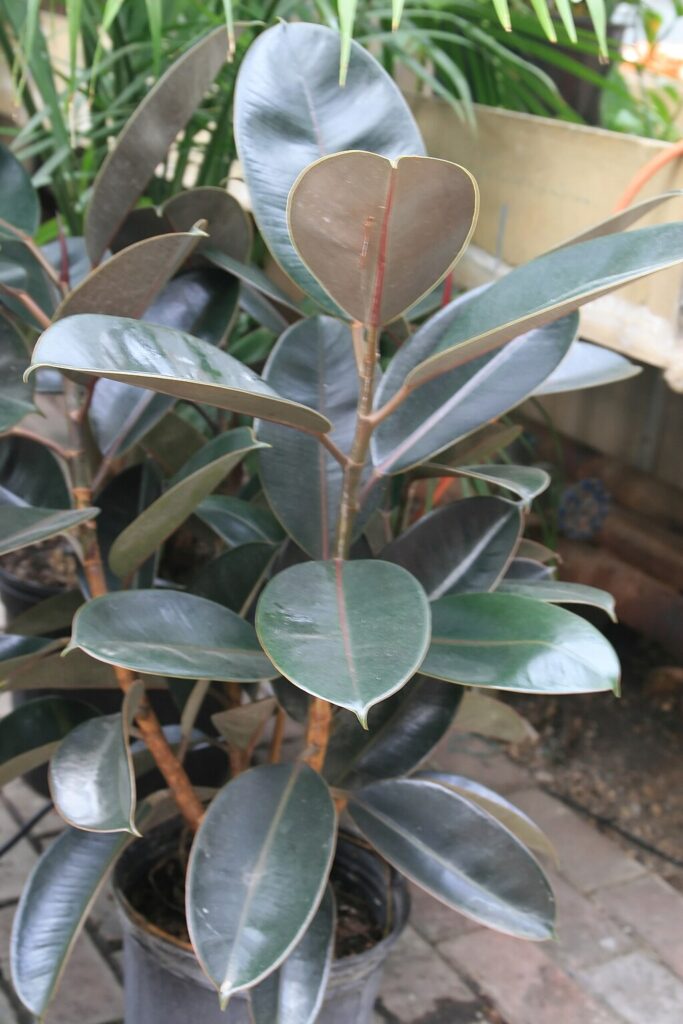
- Light: Prefers bright, indirect light but can tolerate moderate light. Too much direct sunlight can scorch the leaves.
- Watering: Water when the top 1-2 inches of soil are dry. Avoid overwatering to prevent root rot.
- Temperature & Humidity: Thrives in warm temperatures (60°F-75°F / 15°C-24°C). Likes moderate humidity but tolerates average indoor conditions.
- Growth: Can grow up to 6-10 feet indoors in the right conditions. Tends to grow taller and more upright.
- Fertilization: Feed with a balanced fertilizer once a month during the growing season (spring and summer).
- Common Issues: Leaf drop due to overwatering, underwatering, or sudden environmental changes. Brown leaf edges can occur if humidity is too low.
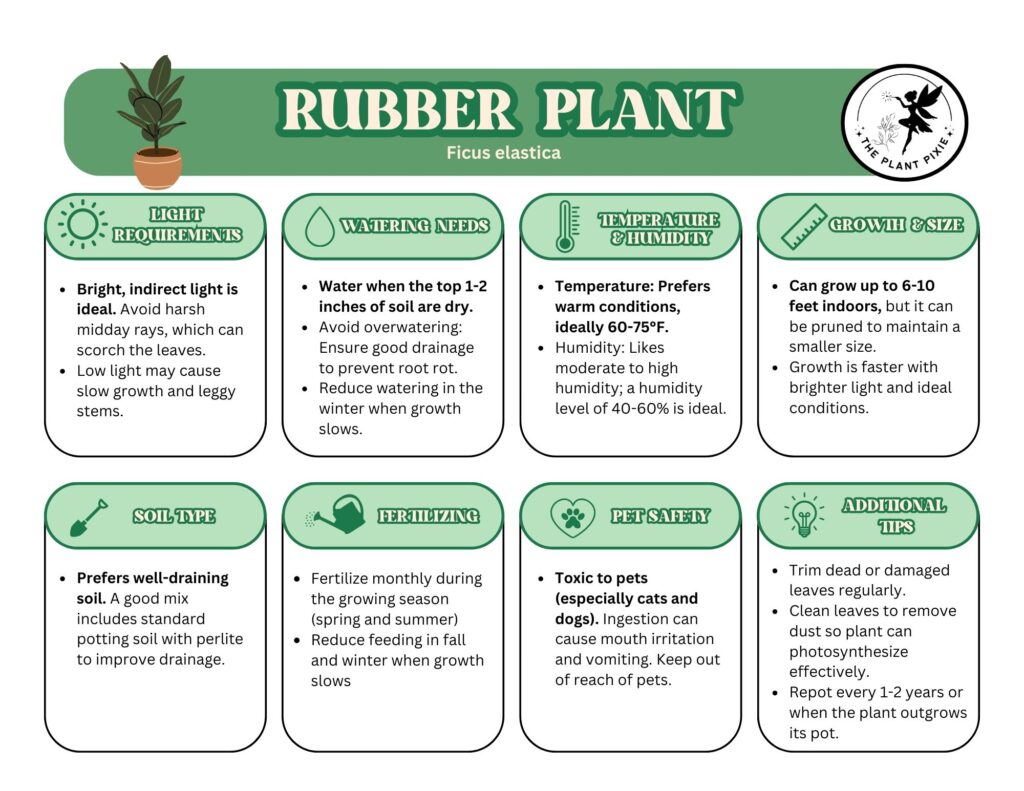
2. Ficus benjamina (Weeping Fig)
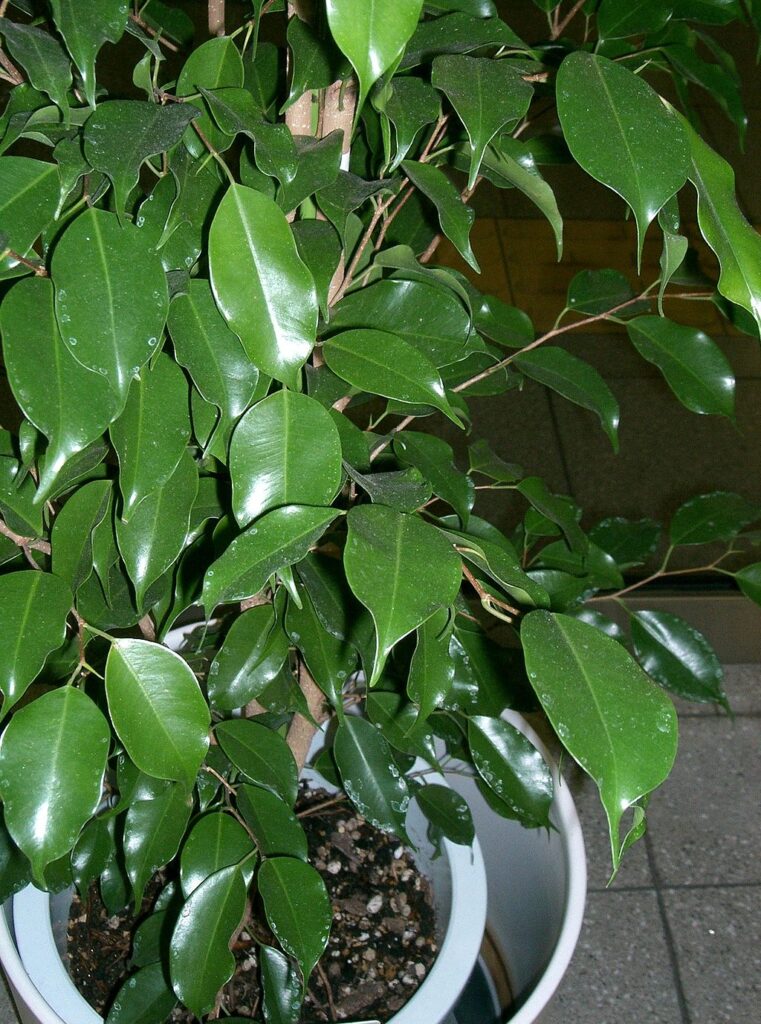
- Light: Prefers bright, indirect light but can tolerate low light. Avoid direct sunlight, which can cause leaf burn.
- Watering: Keep the soil evenly moist but not soggy. Allow the top inch of soil to dry out between waterings. Avoid waterlogging.
- Temperature & Humidity: Prefers warm temperatures around 60°F-75°F (15°C-24°C) and average humidity levels.
- Growth: Grows up to 3-6 feet indoors with a bushy, elegant shape.
- Fertilization: Fertilize once a month during the growing season with a diluted balanced fertilizer.
- Common Issues: Sensitive to environmental changes. May drop leaves if moved or stressed. Yellowing leaves can result from overwatering or nutrient deficiency.
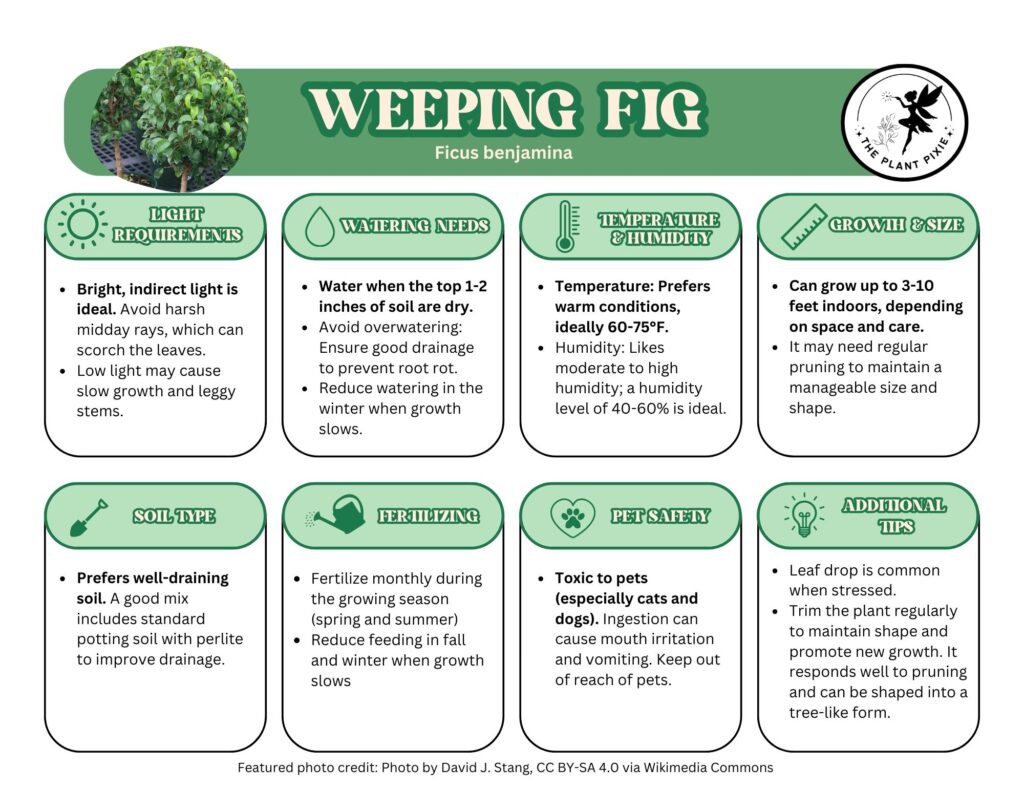
3. Ficus lyrata (Fiddle Leaf Fig)
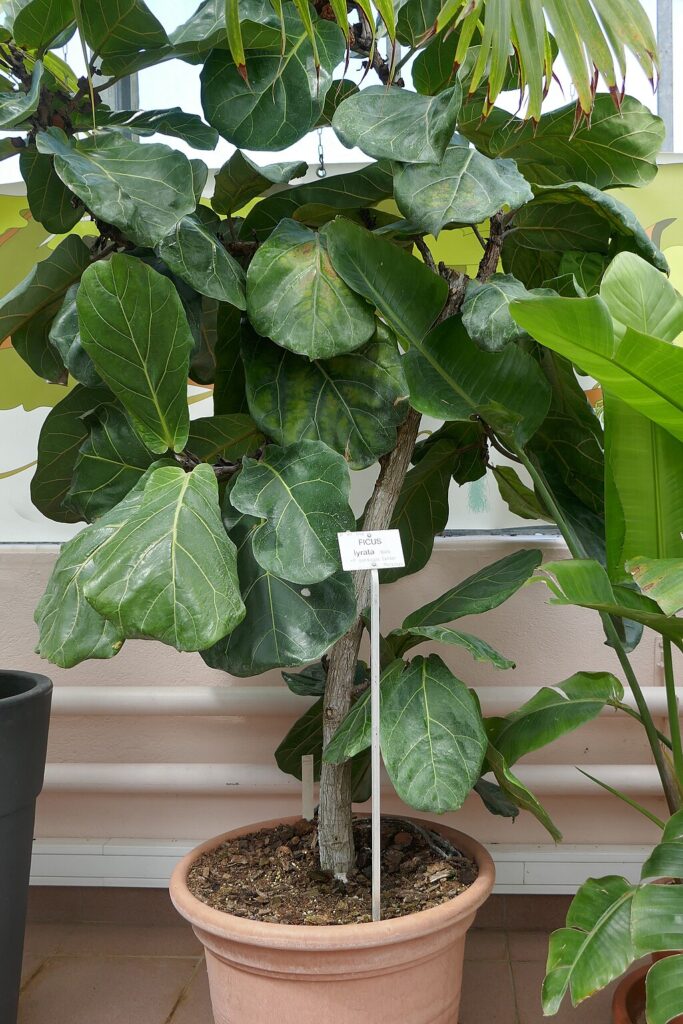
- Light: Requires bright, indirect light, and can tolerate a few hours of direct sunlight. It will struggle in low light and may develop leggy growth.
- Watering: Water when the top 2-3 inches of soil are dry. Avoid letting the plant sit in water, as this can cause root rot.
- Temperature & Humidity: Prefers warm temperatures (65°F-75°F / 18°C-24°C) and higher humidity. Consider using a humidifier if your home is dry.
- Growth: Can grow up to 6-10 feet indoors. Known for its large, bold, violin-shaped leaves.
- Fertilization: Fertilize monthly with a balanced liquid fertilizer during the growing season (spring through summer).
- Common Issues: Brown tips or spots can indicate low humidity, inconsistent watering, or direct sun exposure. Leaves may fall if conditions change too suddenly.

4. Ficus microcarpa (Ginseng Ficus)

- Light: Prefers bright, indirect light but can tolerate low to moderate light. Avoid direct sunlight, which can cause leaf burn.
- Watering: Keep the soil moist but not soggy. Allow the top inch of soil to dry out before watering.
- Temperature & Humidity: Best in warm temperatures (60°F-75°F / 15°C-24°C). Tolerates average humidity but benefits from higher humidity.
- Growth: Grows up to 3-5 feet indoors, with a thick trunk and glossy green leaves.
- Fertilization: Feed monthly during the growing season with a balanced liquid fertilizer.
- Common Issues: Ficus microcarpa is prone to root rot if overwatered. Yellowing leaves can indicate poor drainage or nutrient deficiency.

5. Ficus pumila (Creeping Fig)
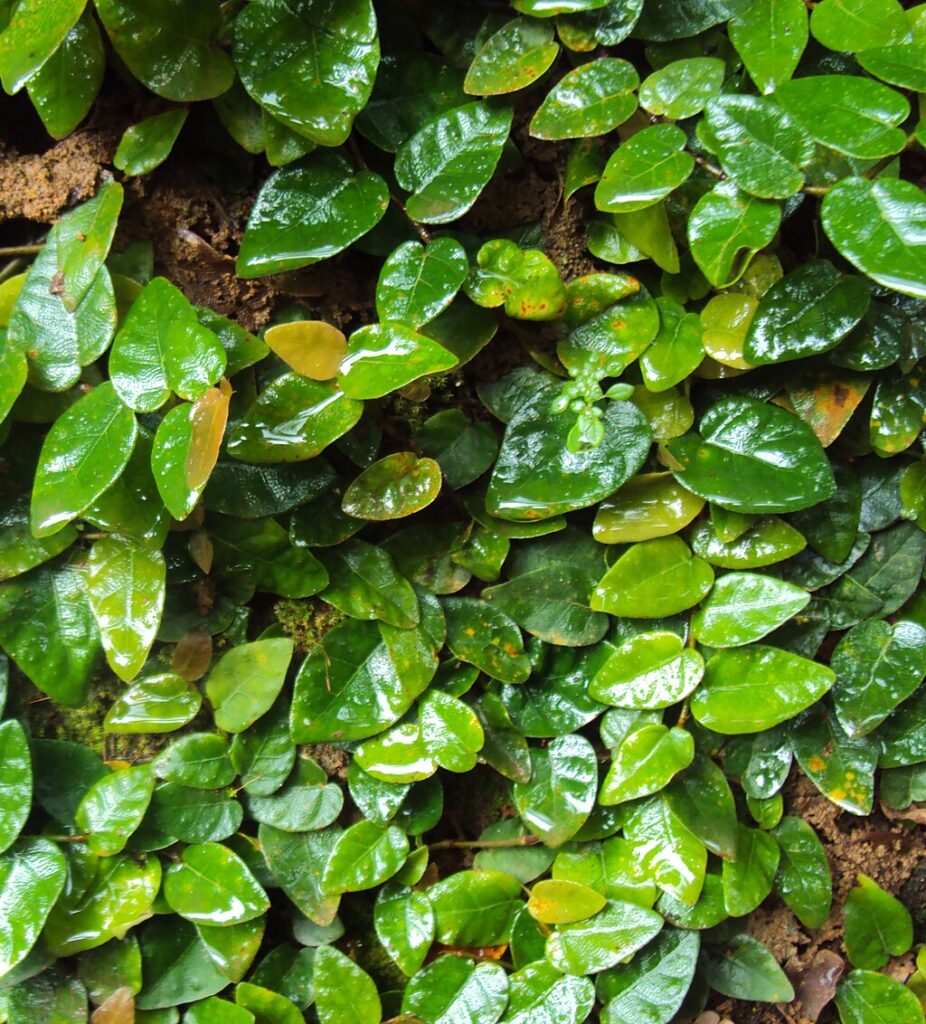
- Light: Prefers bright, indirect light, but can tolerate low light conditions. It can also grow in shaded areas indoors.
- Watering: Keep the soil moist but not soggy. It enjoys consistently damp soil but can tolerate slight drying out between waterings.
- Temperature & Humidity: Thrives in warm temperatures (60°F-75°F / 15°C-24°C) and moderate humidity.
- Growth: Can spread and climb, reaching up to 6-8 feet indoors. Ideal for growing as a hanging plant or on trellises.
- Fertilization: Fertilize with a diluted balanced fertilizer once a month during the growing season.
- Common Issues: Prone to pest problems such as aphids and spider mites. Can become leggy without enough light.
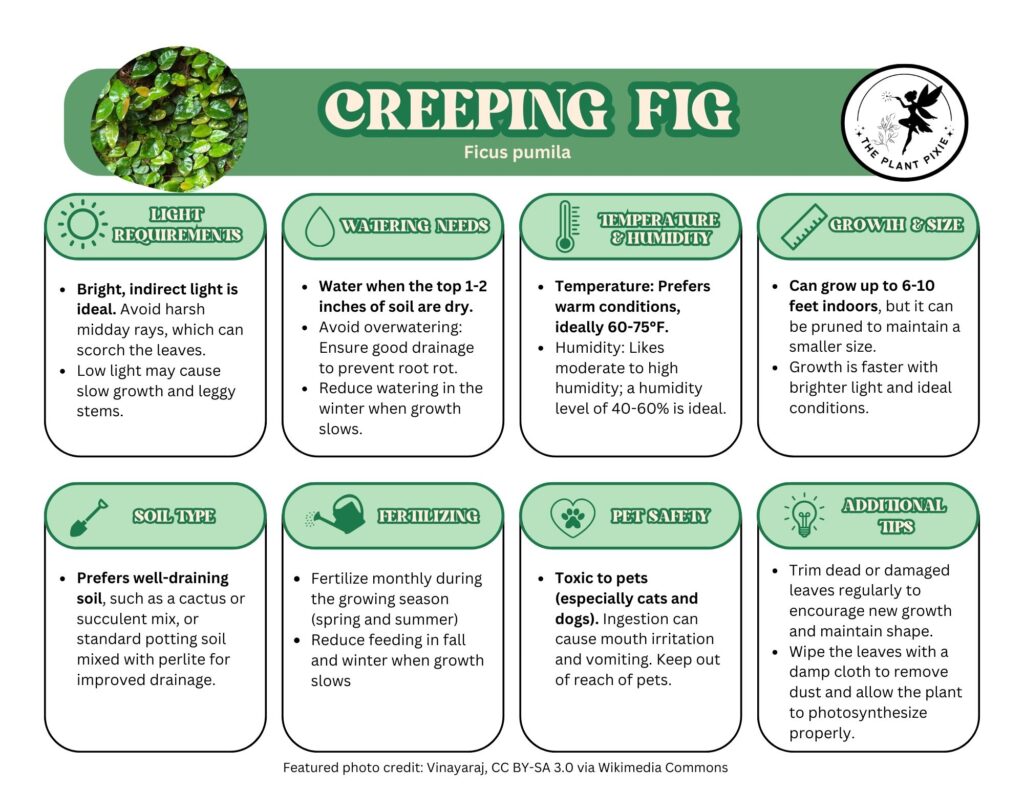
6. Ficus maclellandii (Alii Ficus)
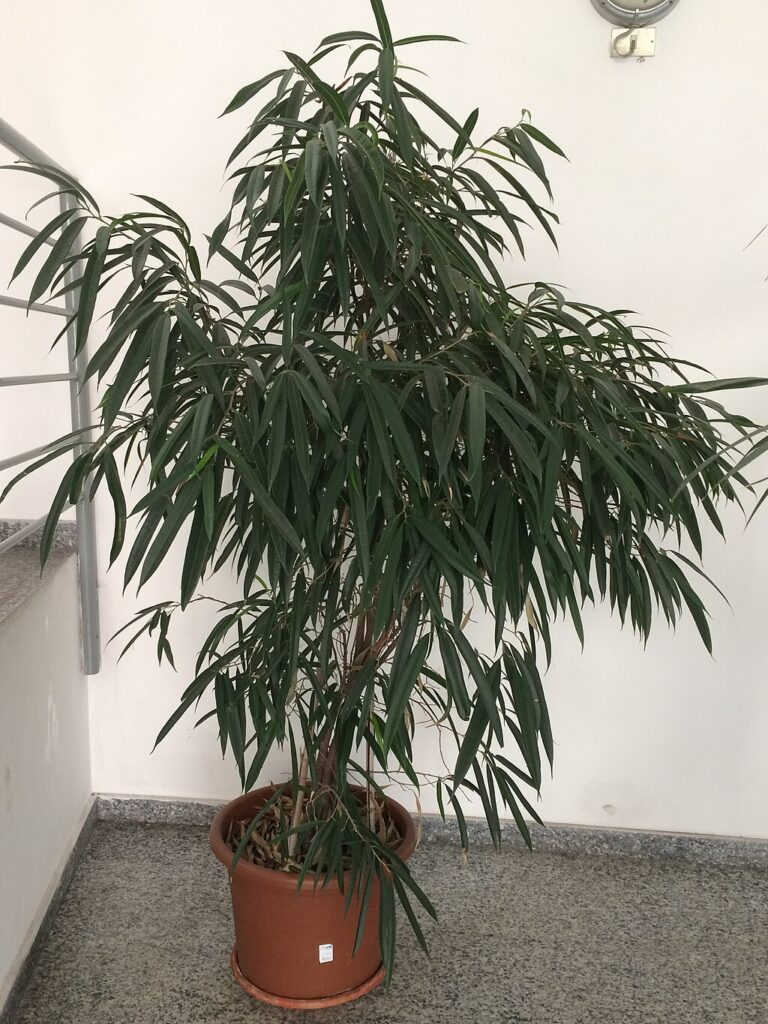
- Light: Prefers bright, indirect light but can tolerate moderate light. It can handle more light than other Ficus varieties but avoid direct sunlight.
- Watering: Water when the top inch of soil is dry. It’s relatively drought-tolerant but thrives with consistent watering.
- Temperature & Humidity: Prefers temperatures of 65°F-75°F (18°C-24°C) and average humidity.
- Growth: Grows up to 6 feet indoors, with long, narrow leaves resembling those of the Ficus elastica but with a softer texture.
- Fertilization: Fertilize once a month during the growing season.
- Common Issues: Can experience leaf drop if moved too suddenly or exposed to drafts. Brown spots on leaves can be a sign of overwatering.
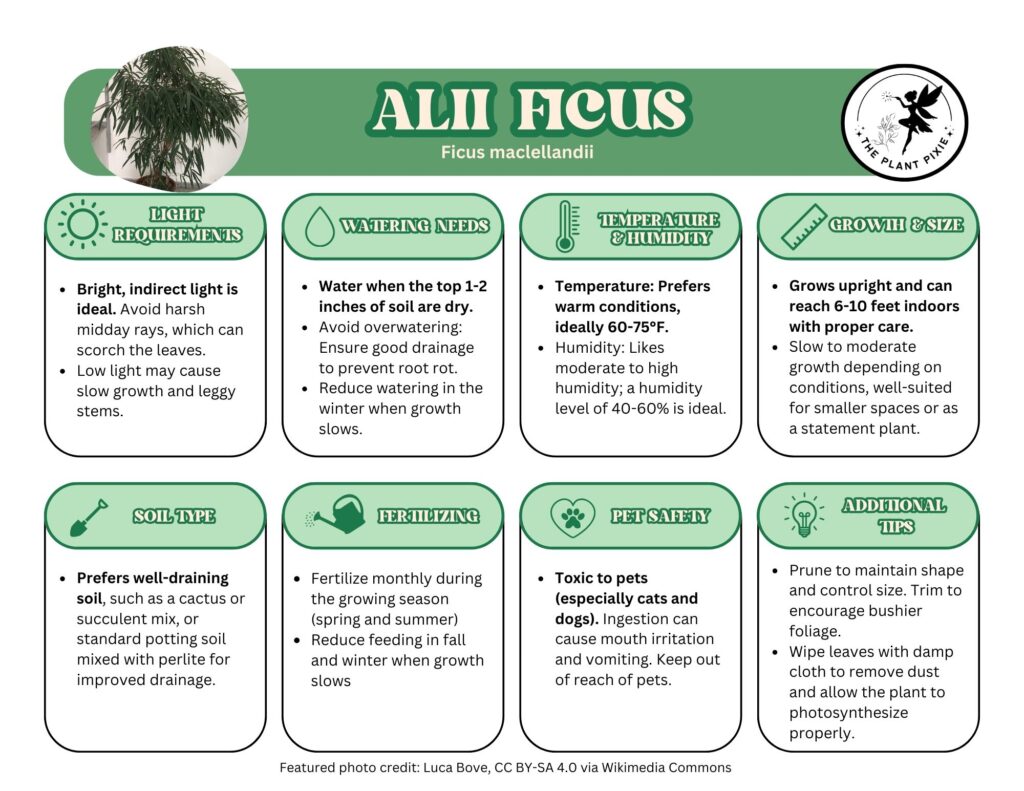
7. Ficus macrophylla (Small-leaved fig)

- Light: Prefers bright, indirect light but can tolerate moderate sunlight. Avoid direct midday sun, which can scorch its leaves.
- Watering: Water when the top inch of soil is dry. Likes to be kept moist but not waterlogged.
- Temperature & Humidity: Thrives in temperatures between 60°F and 75°F (15°C-24°C). Likes humidity but is somewhat adaptable.
- Growth: Can grow up to 6-8 feet indoors, with large, glossy leaves.
- Fertilization: Fertilize monthly during the active growing season with a balanced fertilizer.
- Common Issues: May struggle with root rot if overwatered. Yellowing leaves can be a sign of under-watering or poor light conditions.
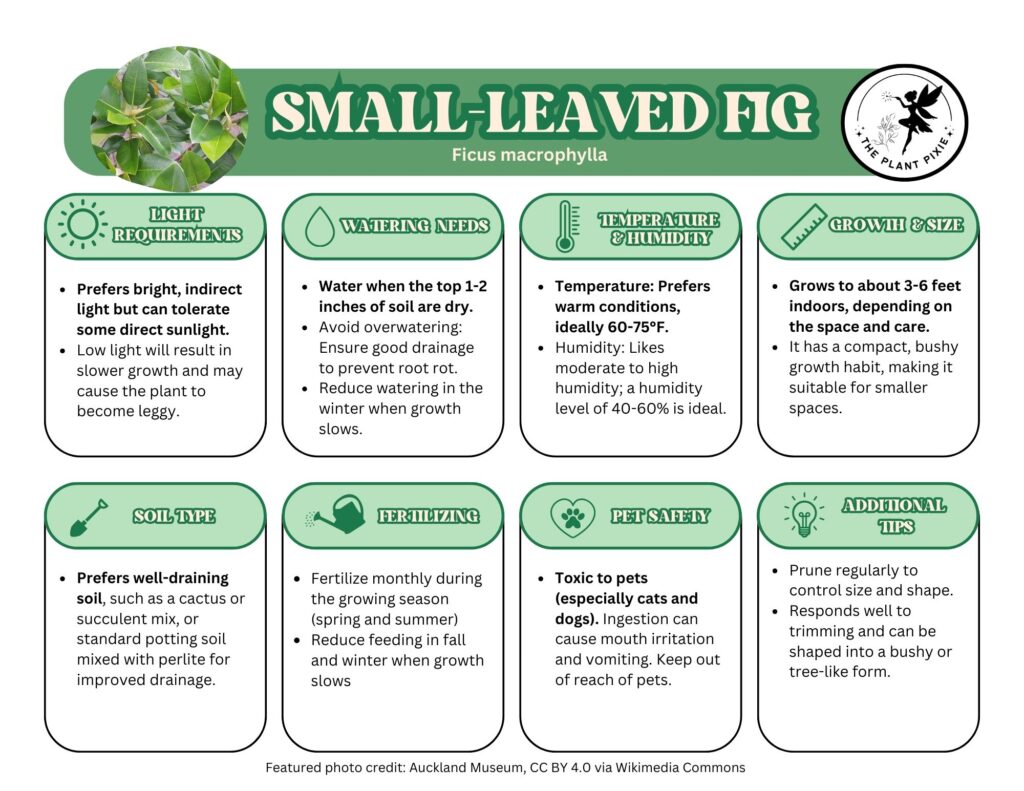
Common Issues and How to Solve Them:
Ficus plants, while relatively easy to care for, can experience a range of common issues that may affect their health and appearance. Here’s a list of some of the most frequent problems among Ficus varieties and tips on how to solve them:
1. Leaf Drop
- Causes:
- Environmental changes (e.g., moving the plant, sudden temperature fluctuations, or drafts).
- Underwatering or overwatering.
- Poor light conditions.
- Solution:
- Avoid sudden changes in the plant’s environment. If moving the plant, do so gradually.
- Ensure consistent watering: Allow the top 1-2 inches of soil to dry out before watering.
- Provide bright, indirect light. Avoid placing your Ficus in dark corners.
2. Yellowing Leaves
- Causes:
- Overwatering or waterlogged soil (roots can suffocate).
- Underwatering, causing the plant to be stressed.
- Nutrient deficiency, particularly a lack of nitrogen or iron.
- Solution:
- Check soil moisture before watering and ensure the pot has good drainage.
- Ensure the plant is getting enough light, as low light can slow down the plant’s growth and cause yellowing.
- Fertilize with a balanced, water-soluble fertilizer during the growing season (spring and summer) to address nutrient deficiencies.
3. Brown Leaf Tips or Edges
- Causes:
- Low humidity, especially in winter.
- Underwatering or inconsistent watering.
- Over-fertilization or salts from fertilizers accumulating in the soil.
- Solution:
- Increase humidity by misting the plant or placing a humidifier nearby. Alternatively, set the plant on a tray with pebbles and water to raise the local humidity.
- Check watering routine: Water when the top 1-2 inches of soil are dry and ensure proper drainage to avoid root rot.
- If fertilizer salts are the issue, flush the soil by watering the plant thoroughly, letting the water drain out completely.
4. Leaf Spots or Discoloration
- Causes:
- Fungal or bacterial infections, often due to high humidity and poor air circulation.
- Water splashing on leaves while watering can cause spots.
- Solution:
- Prune infected leaves to prevent further spread.
- Avoid watering directly on the foliage and ensure the soil is not too moist at the surface.
- Improve air circulation around the plant and allow the plant to dry out between waterings. If necessary, treat the plant with a fungicide.
5. Leggy Growth or Sparse Leaves
- Causes:
- Insufficient light.
- Lack of pruning: Ficus plants tend to get leggy and lose their bushy shape if not regularly pruned.
- Solution:
- Ensure the plant is getting bright, indirect light. If light levels are low, consider moving the plant to a brighter location or supplementing with grow lights.
- Prune regularly to encourage bushier growth. Ficus plants respond well to trimming, which encourages lateral growth.
6. Pests (Spider Mites, Scale, Mealybugs)
- Causes: Ficus plants can attract pests like spider mites, scale insects, and mealybugs, especially in dry conditions.
- Solution:
- Inspect regularly: Check the undersides of leaves for signs of pests.
- Clean the plant: Wipe the leaves with a damp cloth to remove pests.
- Use insecticidal soap or neem oil to treat infestations. For mealybugs or scale, you can use a cotton swab dipped in rubbing alcohol to remove them directly.
7. Root Rot
- Causes:
- Overwatering or sitting in waterlogged soil, which deprives the roots of oxygen.
- Poor drainage in the pot.
- Solution:
- Ensure proper drainage: Make sure the pot has drainage holes and that water can escape freely. Use a well-draining soil mix.
- If root rot is suspected, remove the plant from the pot, trim any rotting roots, and repot it in fresh soil.
- Water carefully: Allow the soil to dry out between waterings. Avoid leaving the plant in standing water.
8. Stunted Growth or No New Growth
- Causes:
- Nutrient deficiency, particularly a lack of essential minerals like nitrogen or phosphorus.
- Temperature stress (too cold or too hot).
- Low light conditions, causing slow or halted growth.
- Solution:
- Fertilize during the growing season (spring to early fall) with a balanced fertilizer.
- Ensure the plant is kept in warm conditions (60°F-75°F / 15°C-24°C) and bright, indirect light for optimal growth.
- Consider repotting the plant if it’s root-bound and unable to take up enough nutrients.
9. Drooping or Wilting
- Causes:
- Underwatering, especially if the soil has dried out completely.
- Overwatering, which can drown the roots and cause them to become mushy.
- Solution:
- Check soil moisture: Water only when the top 1-2 inches of soil are dry. If the plant is underwatered, give it a thorough watering.
- Ensure good drainage and check the roots for any signs of rot if the plant has been overwatered.
10. Curling Leaves
- Causes:
- Overwatering or fluctuating moisture levels in the soil.
- Low humidity or inconsistent environmental conditions.
- Solution:
- Water consistently and maintain stable conditions, avoiding any drastic changes in watering.
- Increase humidity to prevent the plant from drying out, especially in the winter months.
- Check for pests, as some insect infestations can also cause leaf curling.
General Prevention Tips:
- Provide consistent care: Ficus plants don’t like sudden changes in their environment. Keep them in a stable spot with the right light, temperature, and humidity levels.
- Inspect regularly: Regularly check for pests, diseases, and signs of stress (like wilting, yellowing, or leaf drop).
- Repot when necessary: Repot your Ficus every couple of years to refresh the soil and provide enough space for growth.
By staying proactive and following these solutions, you can help keep your Ficus healthy and thriving.
Pruning and Shaping:
- Why Prune Ficus?:
- Encourages bushier growth and maintains a healthy shape
- Removes dead or damaged leaves to improve air circulation
- When to Prune:
- Best time: Spring or early summer during the growing season
- Regularly check for dead or unhealthy leaves
Benefits of Owning Ficus:
- Air Purification:
- Ficus plants, especially varieties like the Rubber Plant, are known for their air-purifying qualities, removing toxins such as formaldehyde and benzene from indoor air
- Aesthetic Appeal:
- Elegant foliage, large statement leaves, and tree-like forms make Ficus plants perfect for adding greenery and visual interest to any room
- Easy Care (for Some Varieties):
- Ficus plants like Rubber Plants and Weeping Figs are relatively low-maintenance once their basic needs are met
- Perfect for beginner plant owners who are ready for a bit of a challenge
Fun Facts About Ficus:
- Symbolism:
- In some cultures, Ficus trees are symbols of prosperity, growth, and vitality
- The Fiddle Leaf Fig, in particular, is often associated with trendy home décor
- Historical Significance:
- Ficus species like the Banyan tree have cultural and religious significance in various parts of the world, especially in India
9. Additional Resources:
Here’s a list of reputable websites that offer reliable and helpful information about Ficus houseplants, their care, and troubleshooting:
1. The Spruce
- URL: https://www.thespruce.com
- About: The Spruce offers a wide range of plant care guides, including detailed articles on different Ficus varieties such as Ficus elastica (Rubber Plant), Ficus benjamina (Weeping Fig), and Ficus lyrata (Fiddle Leaf Fig).
- Why it’s reputable: The Spruce has a team of experienced gardening experts and horticulturists contributing to their content, ensuring accurate and practical advice.
2. Royal Horticultural Society (RHS)
- URL: https://www.rhs.org.uk
- About: RHS provides expert advice on growing Ficus plants, including care tips, troubleshooting, and details about different species and varieties.
- Why it’s reputable: The RHS is a respected organization for plant care and horticultural knowledge with over 200 years of expertise.
3. Gardenia.net
- URL: https://www.gardenia.net
- About: Gardenia offers care tips and growing guides for various Ficus species, from the Rubber Plant to the Fiddle Leaf Fig. They also cover pests, pruning, and common issues.
- Why it’s reputable: Gardenia is known for its well-researched plant guides, regularly updated with accurate, easy-to-understand information.
4. Houseplant Authority
- URL: https://www.houseplantauthority.com
- About: This site specializes in houseplant care, offering comprehensive guides on Ficus plants, their specific needs, and how to deal with common problems.
- Why it’s reputable: Houseplant Authority provides clear, research-backed advice tailored to indoor gardening enthusiasts.
5. The Sill
- URL: https://www.thesill.com
- About: The Sill is a well-known online plant shop that offers care guides for many houseplants, including detailed advice on growing Ficus plants in your home.
- Why it’s reputable: Founded by experienced horticulturists, The Sill combines knowledge with hands-on expertise and offers educational resources for plant lovers.
6. Fine Gardening (Fine Gardening Magazine)
- URL: https://www.finegardening.com
- About: Fine Gardening provides expert advice on all types of plants, including Ficus. They cover growing conditions, pests, maintenance, and more.
- Why it’s reputable: Fine Gardening is a trusted source with a focus on plant care from professionals with horticultural expertise.
7. Gardening Know How
- URL: https://www.gardeningknowhow.com
- About: Gardening Know How offers a variety of articles on houseplants, including Ficus, focusing on care, propagation, and solving plant problems.
- Why it’s reputable: The website features expert gardening advice with practical, easy-to-follow instructions.
8. Plant Care Today
- URL: https://plantcaretoday.com
- About: Plant Care Today provides detailed care instructions for indoor plants, including Ficus varieties. It also covers common issues like pests, diseases, and environmental needs.
- Why it’s reputable: The site features in-depth care information from professional gardeners and plant experts.
9. University of Florida IFAS Extension
- URL: https://sfyl.ifas.ufl.edu
- About: The University of Florida’s Institute of Food and Agricultural Sciences (IFAS) offers research-based guidance on Ficus care, pest control, and other plant-related topics.
- Why it’s reputable: As an academic institution, UF IFAS provides scientifically accurate, evidence-based information on plant care.
10. Gardenista
- URL: https://www.gardenista.com
- About: Gardenista covers a variety of topics, including Ficus care and plant styling. The site features expert plant advice, product recommendations, and design inspiration.
- Why it’s reputable: Gardenista is a trusted source in the gardening and home décor space, combining style with solid horticultural advice.
These websites are great resources for detailed, reliable, and up-to-date information on Ficus plants and houseplant care. Whether you’re a beginner or a seasoned plant enthusiast, these sources will help you keep your Ficus thriving.
Featured image credit: Mokkie, CC BY-SA 3.0 https://creativecommons.org/licenses/by-sa/3.0, via Wikimedia Commons

